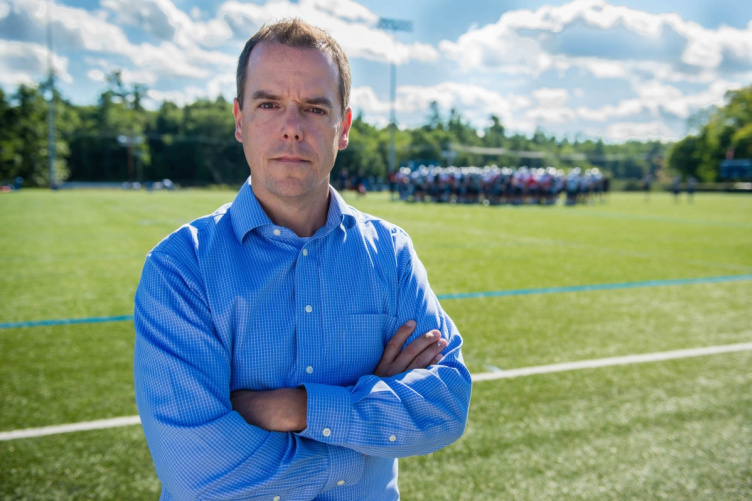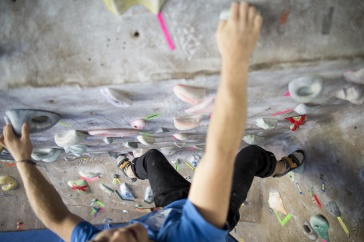
Once a week, several dozen UNH football players participate in an innovative, if counterintuitive, drill to minimize head trauma: They remove their helmets and tackle each other.
The Wildcats are subjects in a two-year study conducted by UNH researcher Erik Swartz to test the effectiveness of the Helmetless Tackling Training, or HUTTTM Technique, he developed to train players to “keep their heads out of the game.” His hypothesis is that practicing tackling without protective equipment will translate into full-contact, fully protected play that minimizes head impact.
“Our primary goal is to reduce head and neck injuries in football,” says Swartz, a professor in the athletic training option of the kinesiology department. “It sounds simple, but if there isn’t contact to the head, there won’t be a head injury.”
Swartz’s work caught the attention of the NFL, Under Armour and GE, which today announced he is a winner of their Head Health Challenge II.
The set of drills, which include player-to-player contact and are brief but very specific, focus more on technique than full effort. “You’re not trying to take the other player down,” says Swartz.
To measure the effectiveness of the drills, the players in the study (25 doing the tackling drills and a control group of 25) wear adhesive pill-sized impact sensors behind their ears for all practices and games. The sensors, which include accelerometers and gyroscope technology, measure the volume, magnitude and location of hits. Swartz and the athletic training students assisting him download the data after practices and games; by the end of next season, they hope the data elucidates the effectiveness of the drills.
“We want to see a decrease in impacts to the head, especially to the front and the top of the helmet,” says Swartz. “In the end, we expect to see that in the treatment group.”
Swartz drew inspiration for HUTTTM from the decade he spent playing rugby, a sport with plenty of tackling and no helmets (some players wear caps to protect themselves from cuts and scrapes). “I tackled quite a bit, but I didn’t lead with my head. It wasn’t protected so I would keep it out of the way,” he says.
For research subjects, Swartz looked out his window to the winning UNH football team, to which he and his students already provide athletic training services. Wildcats head coach Sean McDonnell has been a valuable partner, he says.
“This research could help us figure out how to lessen the amount of concussions in football,” says McDonnell, whose team is 8-1 this season and was just ranked number one in the country in the FCS. “I thought it was a great idea.”
“It’s really been a team effort,” says Swartz, noting that the study has involved a postdoctoral researcher, athletic trainers, the coaching staff and even the athletic director. “I very much appreciate everyone supporting the research.”
With the $500,000 Head Health Challenge II award, Swartz will bring HUTTTM to high school gridders next season. He suspects that younger players with less tackling experience might see even greater benefits from the technique.
Swartz’s HUTTTM evaluation with the UNH football team has received funding from the National Athletic Training Association Foundation and NIH preparedness funding Up-2-NIH from the UNH research office.
-
Written By:
Beth Potier | UNH Marketing | beth.potier@unh.edu | 2-1566

















































